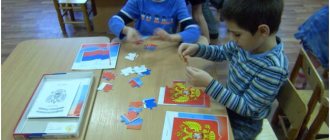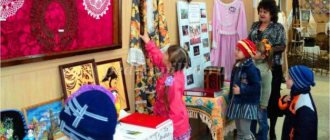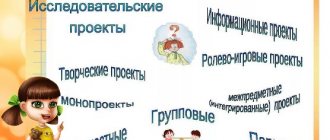Organization of project activities of a teacher in a preschool educational institution.
During the introduction of the Federal State Educational Standard for Preschool Education, kindergarten teachers often began to use the design method in their work. This allows you to successfully plan both the educational process and its results.
Project activities have become a bright, developing, interesting method in the work of teachers. If you apply this method systematically, you can track the effectiveness.
The ability of a teacher to analyze the result of his work, the development of a child as an individual who knows how to think, plan, implement, and be able to apply the resulting product of his work in life, in practice, are important qualities of modern education.
Implementing various projects together with children in kindergarten, involving the parent community in joint activities allows us to raise a child as a creative, independent person who can achieve his goals and objectives. This method, like no other, involves the cooperation of children and adults, which has a positive effect on the child’s psyche and allows him to feel more confident and harmonious in society. Such children graduate from kindergarten and move on to a new level of education at school. More confident, successful, it is easier for them to make contact with adults and peers.
There are many projects that can be applied and used in kindergarten: these are thematic projects (informational, creative, gaming, research). The following projects have been implemented in our kindergarten: “Fantasies with Legos” (game), “Properties and Possibilities of Water” (research), “The Art of Origami” (creative), “Trees and Shrubs of Our Site” (informational). A different number of students took part in the implementation of all these projects. Some projects were prepared by several children, while others required the participation of the entire group of children, and there were also individual ones.
All projects are different in volume and capacity and require different time frames for implementation. For example, a project on the work of the Ural children's writer Pavel Petrovich Bazhov was long-term, lasting the entire academic year. Familiarization with the work of this writer is a very difficult process for preschoolers; the material is very voluminous and requires detailed examination (for example, many words in fairy tales are difficult for a child to understand).
The “Dinosaurs” project was of average duration, the children easily posed and solved the assigned problems, the search for material and its perception was easy. This suggests that this topic is closer and more interesting to the modern child.
When decorating corners in a group, preparing a group for the holidays, children collect information and put it into practice, together with the teacher they come up with how best to decorate the group, for example, for the New Year, in order to take a prize. First, they collect information together with the teacher and parents, then discuss what suits them, what they can handle on their own, and where adult help is needed. To involve me in making attributes, I spent leisure evenings with my parents, where we worked together on preparation. This form of cooperation brings children, parents and kindergarten staff closer together.
The main thing when using project activities is the result. It can be designed and presented in different ways: this is a holiday, and the design of newspapers, albums, exhibitions, as well as playing a game, for example, playing out the characters of a fairy tale, getting into character. Such final events allow children to look for ways to solve problems, solve them in their own way, in an accessible form.
Project activities must be carried out sequentially:
preparatory activity: The teacher, together with the children, formulates the problem, looks for solutions, collects information together with the children, and involves the parent community. Schemes are created, templates, card files, attributes and other necessary material are prepared.
It is decided where, in what place, the selected project will be implemented, and the time frame that will be spent on its implementation is specified.
the project itself, its development: The work plan is determined. System-forming factors are selected. Deadlines are set. The teacher takes an active part in the development of the project, provides assistance if necessary, guides the children, but in no case does the work that the children themselves can do. In the process, children must develop and develop certain skills and acquire new useful knowledge and skills.
checking the quality of the project: There is a self-test, a mental assessment of one’s activities, one’s work. Experts can be selected who will also evaluate the children’s work (kindergarten specialists are selected as experts: speech therapists, physical education instructor, music director, senior teacher, parents). But in no case can an expert be the specialist who helped implement a certain project; he will not have an objective assessment. For example, during the implementation of the project “I love the Urals - my native land!”, the music director was directly involved, she helped in staging the play, and learned songs about the Urals. She is a participant and cannot be an expert.
When checking a project, they assume how it can be used in practice, how work on the project influenced the participants in this project.
If the experts made comments, then the participants (children, teachers, parents) must rethink it, edit it, and improve it.
At this stage, children learn to evaluate their work, accept criticism, correct comments, and improve their work. A sense of responsibility for the quality of your project develops.
After this action, the implementation of the project in practice begins. Some projects do not require going through all of these stages to develop.
A full cycle of all actions is typical for large-scale ideas. Projects that are lighter, smaller in scale, are created in a short time and do not require going through all the stages. They seem to be compressed, rolled up.
Together with the children, we were so carried away by the project activity that we wrote a small quatrain: It is not difficult for us to engage in a project, It carries us away and promises to move forward! It helps us make friends and unite, and gives us new ideas!
Project “Dinosaurs” in the preparatory group in Yekaterinburg.
A project to prepare a group for the New Year together with parents.
Author: Churkina Tatyana Gennadievna, teacher, MBDOU kindergarten No. 463, Ekaterinburg, Sverdlovsk region, Russia
The article is published in the author's edition






